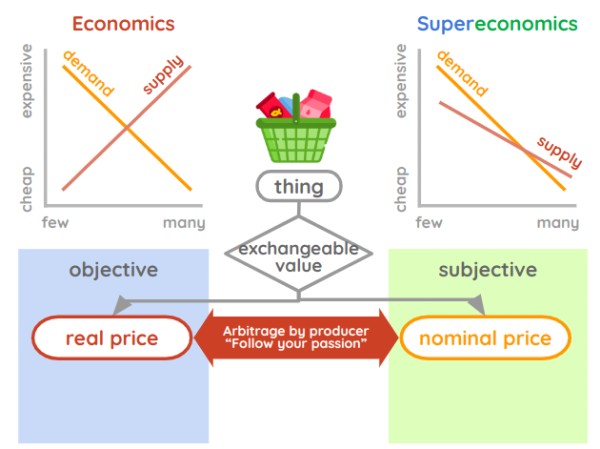The Second Law -- Real Price
Table of Contents
The Second Law of Value states: Value goes from areas with high value to areas with low value in order to spread and remove the lack in society.
This mirrors the First Law of Thermodynamics, known as the law of conservation of energy. It states that energy cannot be created nor destroyed but merely changes forms.
Real Price: Value Creation from Nothing to Something
Real value is created when a person applies effort to create something from nothing. For example, a lettuce seed is not worth eating. But if you plant it and care for it for a few months, it will turn into an edible plant that has value. The lettuce gained value by your effort to convert the seed into food.
However, your lettuce might not be as good as the lettuce grown by a real farmer who is passionate about growing crops. Assume you are an app developer who is passionate about making apps. The farmer cannot make a better app than you just as you cannot grow better lettuce than him.
This leads to the Doctrine of Self-Purpose, derived from the Effort Theory of Value which will be explained in the main Supereconomics book.
In Physics, this is mirrored by the Principle of Least Action wherein a particle takes the shortest path from A to B. We merely use aethereal effort instead of material action since we take a metaphysics-first approach. The main driver of wealth in a supereconomy is the proper maximization and harnessing of collective human effort, like how a completed jigsaw puzzle uses all its pieces (as tiny, incomplete parts of pictures) to make a single big picture.
The Doctrine of Self-Purpose: Alternative to Selfish-Interest
This doctrine says that a person will produce the best value if he focuses on whatever the purpose of his life is:
“Let each of us leave every other kind of knowledge and seek and follow one thing only. This will help us learn and discern between good and evil. In this way, we can always and everywhere choose the better life.”
Socrates
The Republic, Book 10
This is mirrored by the invisible hand.
“The revenue of every society is always equal to the exchangeable value of the produce of its industry. Every one works to render the society’s revenue as great as he can..
By directing that industry to produce the greatest value, he intends only his own gain. He is led by an invisible hand to promote an end which he did not intend. By pursuing his own interest, he promotes the society’s interest more effectively.”
Adam Smith
The Wealth of Nations, Book 4, Chapter 2
Economics corrupts “own interest” to mean selfish-interest:
“Smith proclaimed that every individual, in selfishly pursuing only his or her personal good, is led, as if by an invisible hand, to achieve the best good for all. Any interference with free competition is injurious.”
Paul Samuelson
Economics
In reality, “own interest” matches “self-purpose”, not selfishness. This is proven by unselfish Asian philosophy which is the basis of the wealthy and long-running Indian and Chinese civilizations:
“It is better to do one’s own duty, even he fails to succeed in doing the duty of another. It is better to die doing one’s duty, than to do another’s duty with fear.”
Bhagavad Gita, Chapter 3, Verse 35
“Knowing others is intelligence; Knowing yourself is true wisdom. Mastering others is strength; mastering yourself is true power.”
Tao Te Ching Verse 33
If minimum needs replaces profit maximization, then self-purpose replaces selfish-interest. Thus, a person whose life goal is to grow lettuce will grow the best lettuce at the lowest cost than other people how have a different life goal or purpose. This low cost is the low real price to the planter.
He can then set a high market price and get a lot of revenue by an arbitrage or difference between his low real price and the high market price of his lettuce. At this point, he has filled his part in the jigsaw puzzle of the supereconomy.
“If goods are sold dearer than their natural price, everyone will be oppressed by it. Their interest requires some stock to be diverted towards [producing] those goods in order to reduce their price. In this case, the private interests and passions of individuals naturally dispose them to turn their stocks towards employments most advantageous to society.
Adam Smith
The Wealth of Nations, Book 4, Chapter 7
The Downward Sloping Supply Curve
This leads to a downward-sloping supply curve where the suppliers try to reduce the cost of goods through economies of scale and specialization.

This represents the unity of supply and demand, as the private interests match the common interest. This is opposite of the upward-sloping supply curve of economics which makes the suppliers fight the demanders.
The rivalry and disunity between buyers and sellers was formalized as the Mercantilist doctrine of balance of trade, something that Smith wrote against. It has since evolved to become the “general equilibrium” of Economics (i.e. Dynamic Stochastic General Equilibrium).
“The regulations of commerce are based on the absurd doctrine of the balance of trade. It supposes that when two places trade, neither of them loses or gains if the balance is even. But if it leans to one side, then one loses and the other gains. Both suppositions are false. A trade which is naturally done between any two places is always advantageous to both, but not equally so.”
Adam Smith
The Wealth of Nations, Book 4, Chapter 3
Violations of the Second Law
The violations of the Second Law lead to the following economic problems usually involving the supply-side:
- unemployment, underemployment, skills mismatch, unfilled jobs
- valuation problems such as asset price bubbles
- excess capacity and dumping